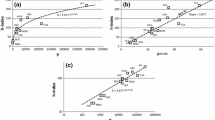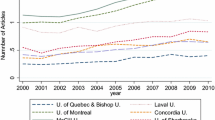Abstract
The paper examines the scientific productivity of male and female scientistts working in the Council of Scientific and Industrial Research (CSIR), India at the overall agency level and at the group of laboratories level, characterized by three broad subjects of physical, biological, and engineering sciences. The productivity of scientists is evaluated on the basis of three parameters: the extent of scientists not publishing any paper, the average number of papers per scientist, and using Lotka's approach. In order to find out whether there is any significant difference between male and female productivity distributions, a Chi-square test is used. Studies the applicability of Lotka's inverse power law and some other statistical models in the distribution of scientific productivity of male and female scientists. Concludes that no significant difference exists between productivity distributions of male and female scientists.
Similar content being viewed by others
References
O. Fulton, Reward and fairness: Academic women in the United States. In:M. Trow, (Ed.),Teachers and Students: Aspects of American Higher Education, New York; Mc Graw Hill, 1975, 199–248.
Cole andH. Zuckerman, The productivity puzzle: Persistence and change in patterns of publication of men and women scientists. In:M. W. Steinkamp andM. L. Maehr, (Eds),Advances Motivation and Achievement, Greenwich, CT; Jai Press, 1984, 217–258.
J. Bernard,Academic Women, Pennsylvania; Pennsylvania University Press, 1964.
K. Garland, Gender differences in scholarly publication among faculty in ALA accredited library schools,Library and Information Science Research, 12 (1990) 155–166.
M. L. Pao, An empirical examination of Lotka's law,Journal of the American Society for Information Science, 37 (1986) 26.
I. K. Ravichandra Rao, The distribution of scientific productivity and social change,Journal of the American Society for Information Science, 3 (1980) 111–120.
W. Lemoine, Productivity patterns of men and women scientists in Venezuela,Scientometrics, 24 (1992) 281–295.
W. Lemoine, The frequency distribution of research papers and patents according to sex. The case of CSIR, India,Scientometrics, 24 (1992) 449–469.
Council of Scientific and Industrial Research,Directory of CSIR Scientists, 5 Volumes. New Delhi: Human Resources Development Group. 1996.
A. J. Lotka, The frequency distribution of scientific productivity,Journal of the Washington Academy of Sciences, 16 (1926) 317–323.
P. T. Nicholls, Estimation of Zipf parameters,Journal of the American Society for Information Science, 8 (1987) 443–445; erratum;Journal of the American Society for Information Science, 39 (1988) 287.
R. Rousseau, A table for estimating the exponent of Lotka's law,Journal of Documentation, 49 (1993) 409–412.
M. L. Pao, Lotka's law: A testing procedure,Information Processing and Management, 21 (1985) 305–332.
J. Berg, R. Wagner-Döbler, A multidimensional analysis of scientific dynamics. Part 1. Case studies of mathematical logic in the 20th century,Scientometrics, 35 (1996) 321–346.
L. Egghe, R. Rousseau,Introduction to Informetrics. Amsterdam; Elsevier, 1990. p. 357.
R. A. Cooper, A. J. Weekles,Data, Models and Statistical Analysis, Hertiage Publishers, 1983.
R. Wagner-Döbler, Where has the cumulative advantage gone? Some observations about the frequency distribution of scientific productivity, of duration of scientific participation, and of speed of publication,Scientometrics, 32 (1995) 123–132.
B. M. Gupta, C. R. Karisiddippa, Productivity of authors as reflected by duration of their scientific participation and speed of publications,Scientometrics, 39 (1997) 281–291.
Author information
Authors and Affiliations
Rights and permissions
About this article
Cite this article
Gupta, B.M., Kumar, S. & Aggarwal, B.S. A comparision of productivity of male and female scientists of CSIR. Scientometrics 45, 269–289 (1999). https://doi.org/10.1007/BF02458437
Received:
Issue Date:
DOI: https://doi.org/10.1007/BF02458437




